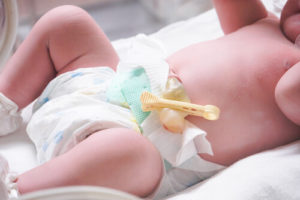Umbilical Cord Complications

As most people are aware, the umbilical cord is a child’s lifeline before birth. Unfortunately, however, there are numerous types of complications that can affect the umbilical cord, all of which can have devastating consequences if not caught early and immediately addressed.
Overall, not every type of umbilical cord complication can be detected right away. In fact, many become evident right before or during delivery, which may lead to serious and life threatening birth injuries. If medical professionals failed to take action and your child suffered life-altering harm, please call Stern Law, PLLC at (800) 462-5772 for a free consultation.
Types of umbilical cord complications
There are a number of complications and abnormalities that can affect the umbilical cord, some of which are completely unpreventable. These include the following:
- Single umbilical artery – Normally, an umbilical cord has three blood vessels that provide vital nutrients to an unborn baby – two arteries and one vein. However, in a very small number of pregnancies (approximately 1%), the cord will only have two blood vessels, resulting in a missing artery. Single umbilical arteries tend to occur more frequently in Caucasian women and may lead to serious fetal abnormalities, such as a cleft lip, spina bifida and trisomy 21. While the cause of this condition is generally unknown, it has been shown to more commonly arise in women pregnant who suffer from diabetes. A simple ultrasound should be able to diagnose the condition rather immediately, allowing for a child to receive the preventive treatment it needs to avoid further complications from occurring.
- Vasia previa – This is a serious pregnancy-related condition that occurs when the cord and its blood vessels grow outside of the amniotic sac next to the protective membranes surrounding the baby. As a result, this creates a significant amount of pressure on the umbilical cord’s blood vessels, which can result in excessive bleeding and oxygen deprivation. While vasa previa affects one in every 2000 to 3000 births, approximately, 95% of babies that experience this condition are stillborn should it not be diagnosed early enough to perform a Cesarean section and prevent further damage. The underlying cause of this serious complication remains unknown however, it can be detected via ultrasound or color doppler ultrasound (this enables a doctor to visualize the matrix of vessels). The greatest risk to a child with regard to vasia previa is the risk of exsanguination, or bleeding out due to the pressure placed on the vessels of the umbilical cord. Early prenatal diagnosis of vasia previa greatly affects a child’s survivability and prognosis, and can prevent this serious side effect from occurring.
- Umbilical cord prolapse – This condition arises when the umbilical cord descends into the vagina after a woman’s water breaks. As the baby moves down through the cervix during birth, it places pressure on the cord, potentially depriving a child of life sustaining oxygen. An umbilical cord prolapse constitutes a serious emergency. Overall, a woman can detect when a prolapse occurs by feeling something located within the vagina right after her water breaks. Through a cervical exam, a doctor can determine whether this condition has arisen, likely resulting in his or her immediate order for a cesarean section. A prolapsed cord is typically associated with children born in breech positions, preterm babies, and multiparous women (a woman pregnant with multiples).
- Nuchal cord – This occurs when the umbilical cord becomes wrapped around various parts of an unborn child – typically around his or her neck. This is caused by fetal movement that results in the cord looping around the baby. Specifically, one loop forms around a baby’s neck in about 20% of cases, with more than one loop forming in about 2 per 1000 births. This condition can be picked up by color doppler ultrasound. The good news is that this does not always result in the need for intervention and may not cause a child to become injured. Fetal monitoring as well as a cesarean delivery may reduce the complications associated with this condition.
- Umbilical cord knots – True umbilical cord knots occur in less than 1% of pregnancies, especially with multiples. To illustrate, knots are more likely to form in a multiple gestation pregnancy due to the increase in fetal movements and the greater amount of amniotic fluid necessary to sustain the pregnancy. Knots are typically caused when the umbilical cord is too long, and may result in a reduced supply of oxygen to an unborn child. A routine ultrasound may not always pick up whether umbilical cord knots are present. Depending upon the circumstances, a cesarean section may be immediately necessary to save the child from brain damage and death as a result of this serious complication.
- Umbilical cord stricture – This arises when the umbilical cord becomes compressed, occurring in about one per 250 births. Fetal abnormalities may be caused if the stricture occurs for a prolonged period, such as cleft lips, trisomy 18, ventricular septal defects, and other serious defects. Most infants do not survive a cord stricture, resulting in a stillborn birth. The underlying cause of an umbilical cord stricture is not fully known.
- Umbilical cord cysts. These occur in about 3% of pregnancies, which refer to abnormal growths that form on the umbilical cord. They can either be pockets that are filled with fluid (known as false cysts) or cells remaining from early fetal development (true cysts). At times, cysts can lead to birth defects and are often detected during the first trimester using a color doppler ultrasound.
Umbilical cord complications most often result in oxygen deprivation. When this occurs, the baby could suffer multiple forms of brain damage. If a child is deprived of life-saving oxygen and/or blood for a sustained period of time, he or she may be stillborn.
Many times, umbilical cord complications could have been avoided had certain risk factors been immediately identified and addressed. If you suffered from umbilical cord complications despite having regular prenatal care, you may wish to consider your legal rights and options. To speak with an experienced birth injury lawyer, please call Stern Law, PLLC at (800) 462-5772 for a free consultation.







